‘Behemoth’ is a word which springs to mind or, perhaps more nautically, ‘leviathan’.
- Classic sportfisher looks, large cockpit
- Plush ride, excellent fuel economy
- Simple mechanical systems
- Fits a 10.5m berth
Night Hawk II is the umpteenth Caribbean to carry that name in Scott White’s long association with this well-respected Australian GRP boat brand. She is Caribbean Boats New Zealand’s latest demonstrator, a 32-foot flybridge (FB) model set up specifically for the White family, who enjoy sport and big game fishing, along with social cruising out of Whangamata.
The Caribbean 32 is closely related to its slightly larger sibling the Caribbean 35 and is sometimes overlooked in favour of the bigger boat, says Scott, but the smaller vessel gives nothing away in terms of utility or performance – and it fits neatly into a 10.5-metre berth, a major plus in these days of rising marina berth prices and general berth scarcity, especially in the more popular lengths.

As a Caribbean Boats’ demonstrator and his personal vessel, Scott has added a lot of kit to what left the factory as a fairly simple, though decently specc’d, basic vessel. For example, instead of electronic common-rail diesel engines, Nighthawk II features a pair of fully mechanical Yanmar 240hp diesels running shafts for ease of operation, maintenance, and repair, there’s no teak anywhere; the gelcoat is plain white (no colours or tints) and it was delivered without electronics or kitchen appliances.
This approach allows Caribbean NZ offer customers a base boat as a competitive value proposition – no frills, but with the exemplary handling and ride Caribbeans are known for – or a higher spec version like Night Hawk II with many added extras.
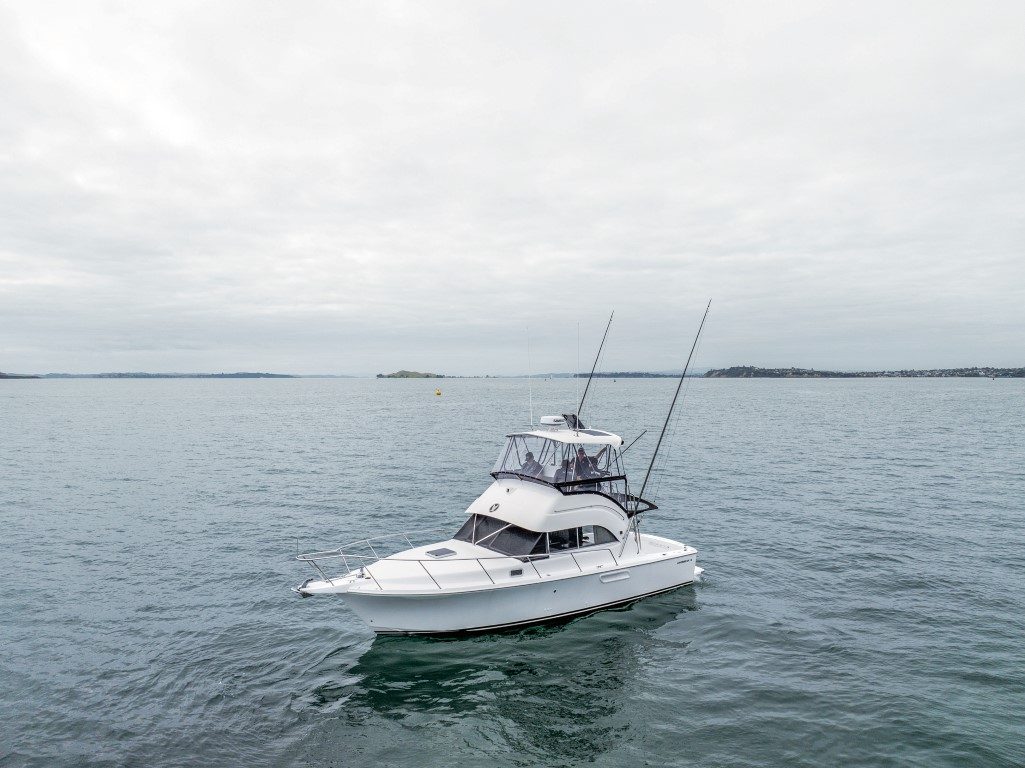
Night Hawk II certainly doesn’t lack equipment – on the contrary. Scott’s made sure to include lots of extras to suit his family’s boating needs, many of them fitted in New Zealand after he took delivery of the vessel. This has been Caribbean NZ’s usual practice for 15 years, working with local marine businesses such as Hutchinson Boat Builders, Pro Marine Electrical, Tauranga Bridge Marina Hardstand and Advance Trident, among others.
As well as fitting a full suite of Simrad electronics, including an Evo3S 16-inch MFD, Halo Radar, Simrad autopilot including handheld remote, a top-spec S5100 sounder module with B275 transducer (this is a sportfishing vessel, after all), he’s opted for a Zip Wake dynamic trim control system and a Wallas diesel cooktop that also serves as a saloon heater for winter boating (with its own fuel tank and transfer system from the main diesel supply), all courtesy of Advance Trident.

The extras and upgrades list is too long to list, but standouts include Ocean Blue gamepoles, Vulcan anchor and swivel, Cockpit sunshade, upgraded house batteries with solar charging and Victron battery management.
Scott also fitted a hatch to the GRP hardtop for ventilation when the Strataglass clears are zipped closed, as well as easier access to the radar and aerials, additional drink holders, 12V and USB charging ports, Perko rodholders, a rocket launcher, a Kilwell centre rigger and cockpit icebox refrigeration.

Stepping aboard the Caribbean 32 FB brought back memories of other Caribbeans I have reviewed over the years. They all share similar styling and essentially the same hull, directly descended from the Raymond Hunt designed racer Moppie. The 31-foot Moppie, built in wood, revolutionised offshore powerboat racing in the early 1960s and subsequently spawned highly successful mainstream models in fibreglass by Bertram, and later Caribbean under licence, among others.
At 32 feet (10.385m) the Caribbean 32 is very close in length to the original Moppie. By today’s standards she’s relatively small for a launch, but the design has been tweaked to ensure there’s good headroom in the saloon even with a flybridge (the saloon floor has been lowered), two decent cabins below decks, a roomy bathroom with separate shower, and a large, very workable ‘fisherman’s’ cockpit.
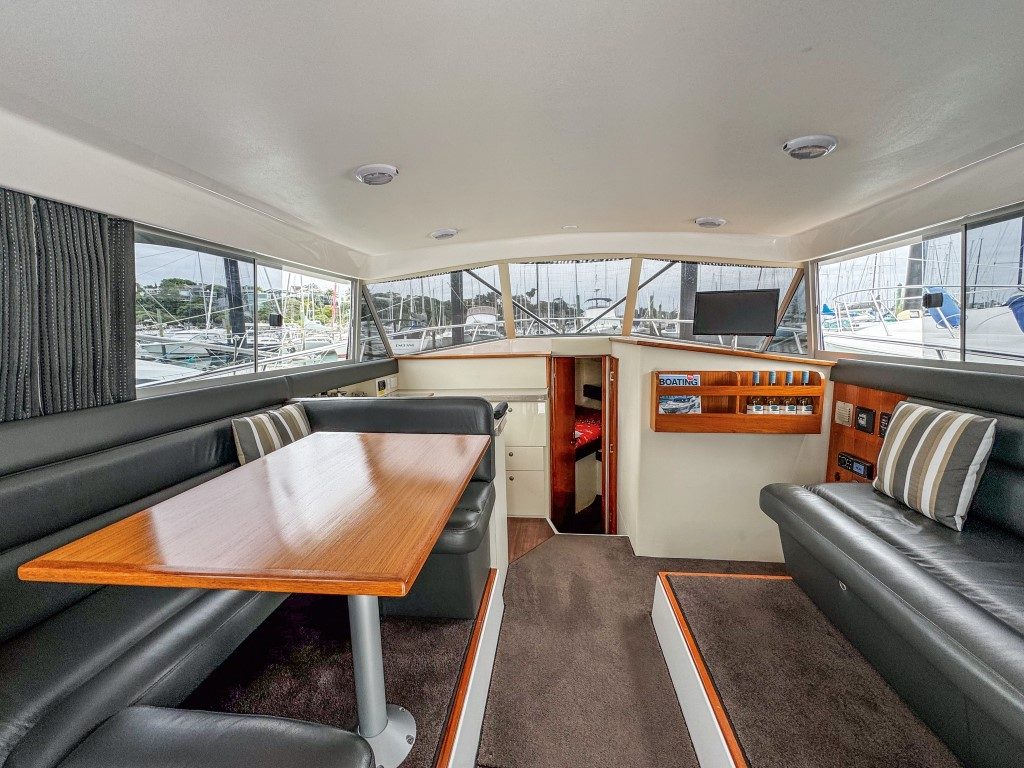
Measuring 69ft2 (6.4m2), the Caribbean 32 has a bigger cockpit than many much larger boats. It’s self-draining too, with deep gutters in the deck hatches draining overboard as well. The boat’s stainless steel rope guards in the corners and on the swim platform corners were added in New Zealand.
The transom door on the starboard side opens outwards and the boarding platform is modest and relatively high off the water – with this platform, backing up on a fish shouldn’t be an issue. The cockpit has good storage under the sole, which is plain stippled fibreglass, and in the side pockets. Perko rodholders, Game poles, a custom rocket launcher, twin transom bait wells, hatch access to the steering gear aft, a cockpit freshwater shower and a freezer against the saloon bulkhead round out the cockpit facilities. The vessel’s hot water cylinder is heated by the engine or shore power back at the marina.

The saloon is compact but big windows and light-coloured leather upholstery and a white gelcoat ceiling give it a feeling of space. The raised dinette to port can seat four, maybe five, and there’s room for at least three more on the settee to starboard. This pulls out to make another berth if required, though you wouldn’t want to be too tall.
The galley, also compact, is forward, tucked under the windscreen on the port side. It gets plenty of light and sliding side windows take care of cooking fumes. The cooker is diesel and double as a heater, there’s a small fridge under the bench, an in-bench rubbish bin, storage drawers and lockers, and a wraparound moulded countertop. A modest factory supplied LED TV is mounted on the dashboard to port above a wine bottle shelf and the main 12V and 240V switchboards, Fusion stereo head unit, RCD breaker and voltage meter under the windows to the side.
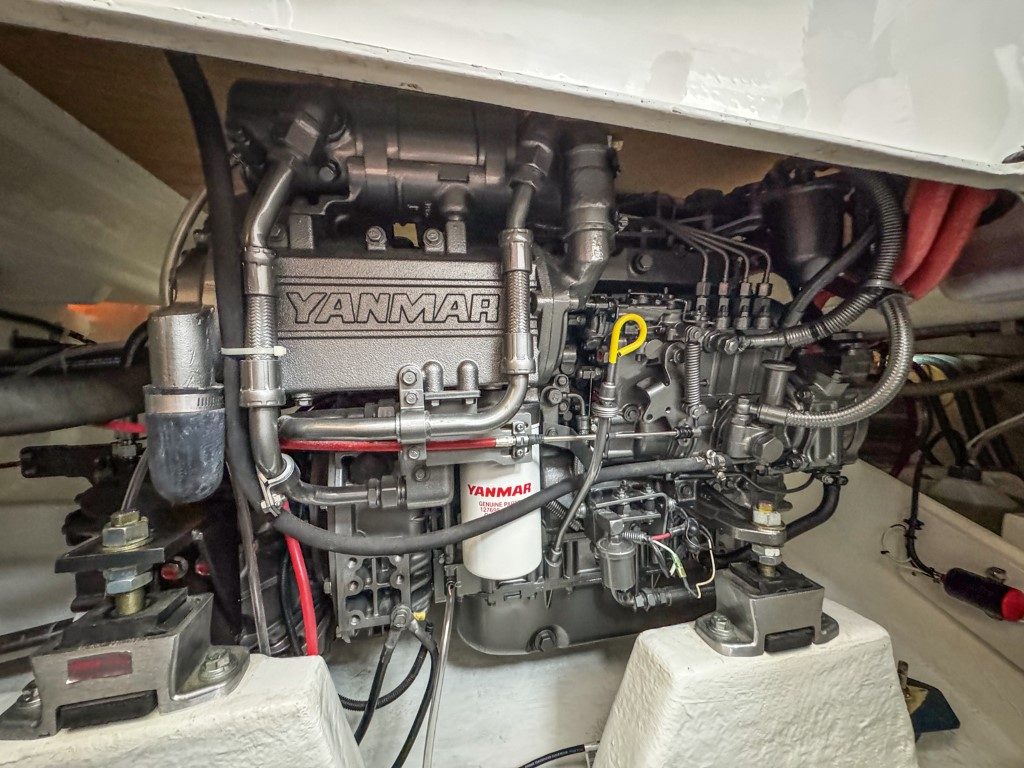
Engine room access is via a hatch in the saloon sole. This allows routine servicing, battery bank access and systems monitoring, but it’s a crawl space – the whole saloon floor can be lifted out by removing a few bolts if more extensive engine work is required.

Accommodation below decks is pretty decent, with a bunk room to port, the main cabin forward with an angled double berth, locker and shelf storage, and a shared bathroom to starboard. The bathroom has a vanity, mirror, separate shower compartment and an electric toilet behind the door. All the soft-vinyl-lined cabins have opening ports or hatches, carpets, and teak doors.
Conning Night Hawk II takes place from the flybridge, which has a large, moulded helm console and two comfortable helm seats side by side. There’s also lounging seating for five or six more up on the flybridge, which feels very spacious for a 32-foot boat.

A fibreglass hardtop (with a hatch added in NZ) and wraparound Strataglass clears means the flybridge is comfortable and dry, winter and summer. In good weather unzipping the clears allows a wind in your face experience, but all-round vision is excellent with or without the clears.
The helm console has enough space for all the usual switches and controls. There’s only one MFD, but the console can be specified for two. In this case it’s moulded to accept Morse cable controls – two sets of levers on the dash – and the Yanmars’ analogue gauge panels, which take up quite a lot of space. The VHF radio and stereo head units are mounted overhead in the moulded headlining and there’s a remotely operated electric capstan on the bow.

Underway the Caribbean 32 impresses with its plush ride. The Caribbean’s solidly built hull benefits from International Marine’s experience building more than 60,000 GRP hulls since 1958. Performance is decent, too, with a comfortable 21-knot cruise and a top speed of around 27 knots full of fuel and water. Night Hawk II carries 855 litres of fuel and 180 litres of water for a displacement of around 6,500kg in cruising trim.
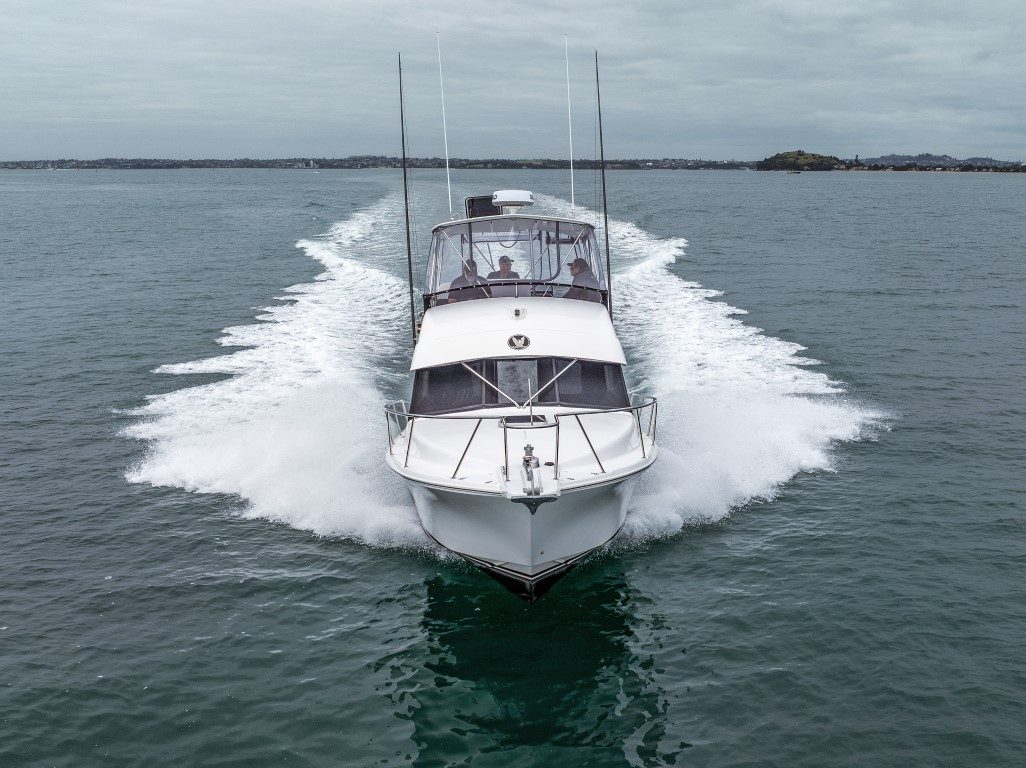
The Yanmars are smooth, but the lack of common-rail fuel injection is evident when accelerating – there’s a puff of smoke and a touch of old school turbo-lag when you push the throttle levers forward. You also need to be adept at two handed boat driving come docking time, one hand taking care of the forwards and reverse levers and the other manipulating the throttle levers for each engine. Again, old school, but Scott made it look easy.
And as Scott points out, a fully mechanical system has some advantages. It’s not susceptible to electrical gremlins, is cheaper to buy (as are mechanical engines), easily adjustable, and straight-forward to fix with onboard tools should something go wrong.
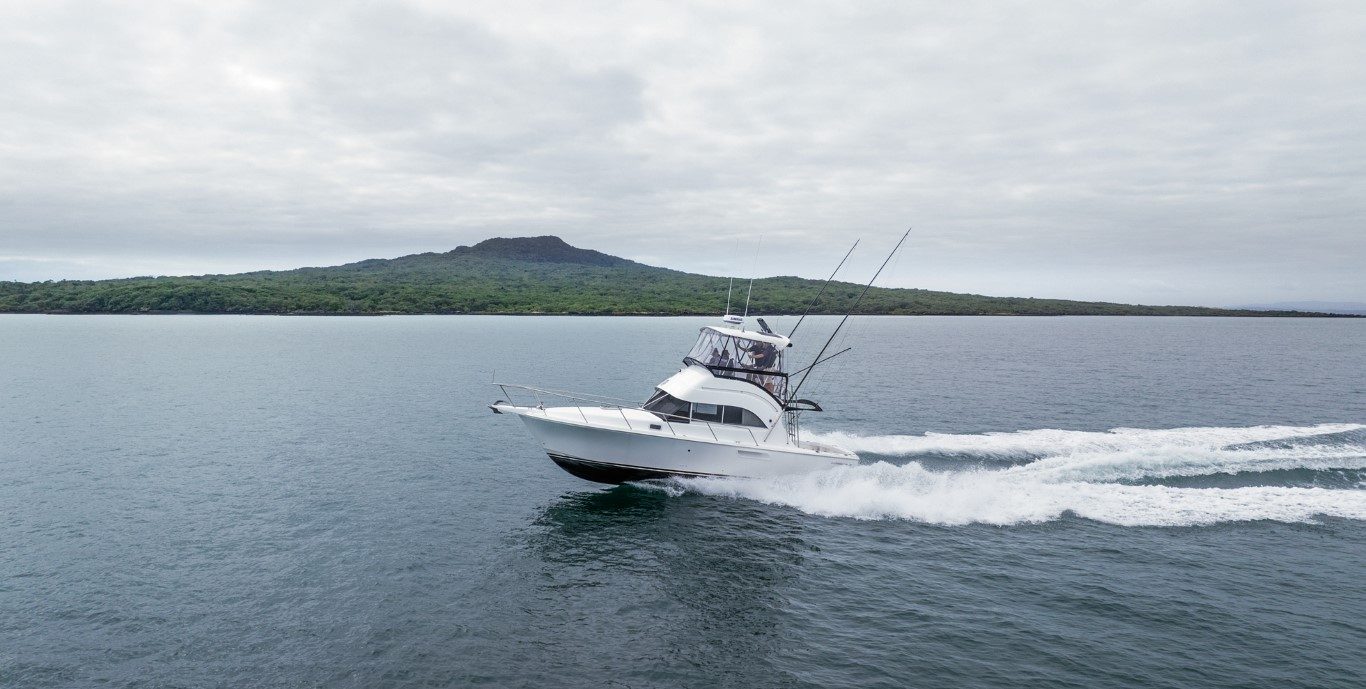
At cruise speed the fuel burn is a very respectable 60 litres per hour total. Scott reckons he can run out wide and troll all day chasing marlin using only 250 litres of diesel. The autopilot is controlled via a display on the touchscreen Simrad MFD, which is simple and convenient at the helm, or via the handheld remote from anywhere onboard.
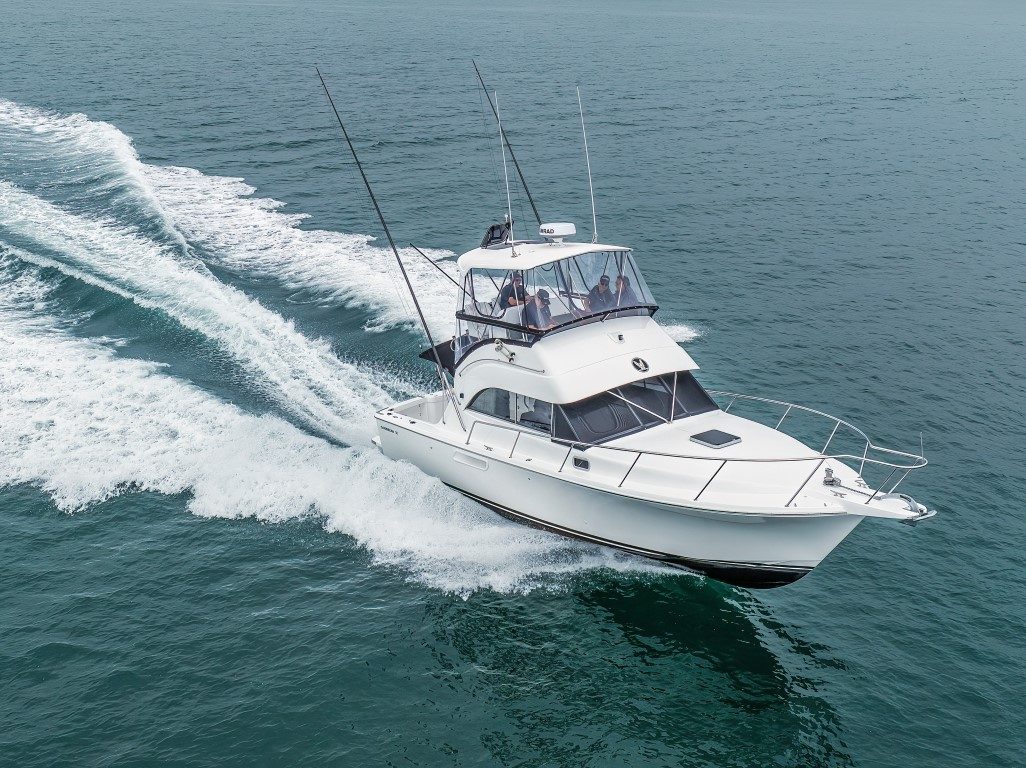
The Caribbean 32 is an easy and enjoyable boat to drive, very responsive to the helm and providing a ride quality that’s hard to beat, especially in this size range. She’s a dry runner, too. With classic styling, good performance and class-leading ride and handling, there’s a lot to like about the Caribbean 32. By offering mechanical rather than electronic engines, pricing is attractive, especially if customers are happy with a stock boat – Caribbean NZ can add whatever the new owner desires here in New Zealand. It’s a formula the White brothers, Scott and Paul, have successfully applied for more than 15 years – this incarnation of Night Hawk II is simply the latest example.
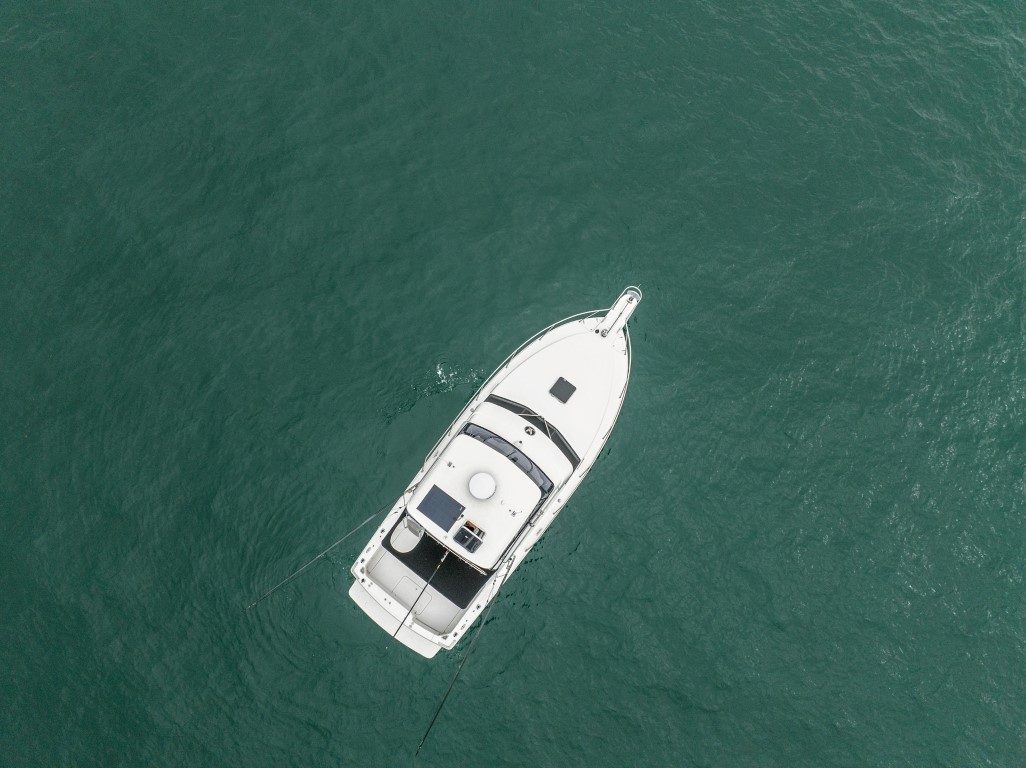
‘Behemoth’ is a word which springs to mind or, perhaps more nautically, ‘leviathan’.
White Pointer has earned the respect of discerning customers in New Zealand and Australia, attracting a loyal and ever growing following for its high-quality, rugged and totally dependable aluminium trailer boats.
The hardtop SP635 shares the same underpinnings as the popular SF 635 which was a completely new model back in 2020.
The pride and joy of a multi-generational family, Bliss resides on a pier that’s home to a couple of other Elite motor launches – Sandspit Marina is a hot-spot for the Bill Upfold-designed vessels, with several calling this small marina home.